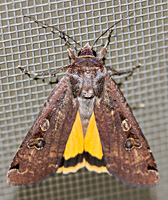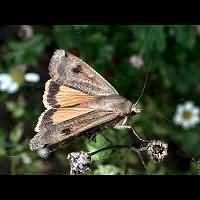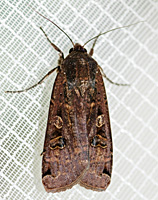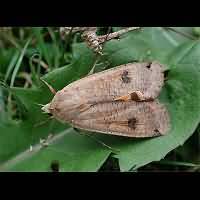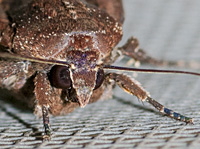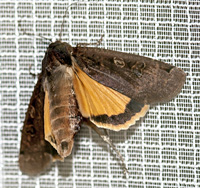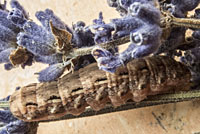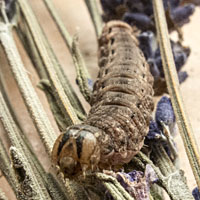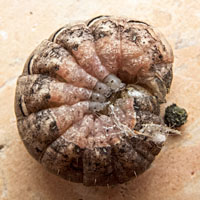[All pictures of garden wildlife on this page are thumbnails. Click on any thumbnail for a large format to be displayed.]

Large Yellow Underwing (Noctua pronuba)
| Taxonomy | ||||||
|---|---|---|---|---|---|---|
| Kingdom: | Phylum: | Class: | Order: | Family: | Genus: | Species: |
| Animalia | Arthropoda | Insecta | Lepidoptera | Noctuidae | Noctua | N. pronuba |
The Large Yellow Underwing is a relatively huge, very variable Noctuid. It belongs to the underwings, a group of Owlet Moths with rather dull frontwings and very colourful underwings. Male and female differ from one another. Males have dark upperwings, usually brownish, greyish or even blackish and the wings are marbled. The upperwings of the females are much lighter (yellowish brown or greyish) and almost unmarbled. All animals depicted on our site are females. A characterisc feature is the small black spot near the tip of the wing. The underwings though are conclusive: entirely yellow with the exception of a rather small blackish band near the edge. Other yellow underwings always have some more black smears or spots in the yellow. The only similar species, the Lesser Yellow Underwing, is always smaller. The Large Yellow Underwing has a wingspan ranging from 5 to 6 cm.
From July onwards the eggs are being laid, often in large groups, on grasses and other low plants. They don't hatch till the end of August or September. The young caterpillars are active during the day. Usually they first eat the egg shell. Then they spin a tiny wire, which they hold up in the air. The wind catches these wires and lifts up wire and caterpillar and disperses them over a vast area. This is similar to what happens to some spiderlings. Once arrived on a suitable host, the larvae start eating, mould and then change into creatures of the night, hiding underground during the day. It is the caterpillar of the Large Yellow Underwing overwintering, but they stay active during mild nights. The larvae are greyish brown or greenish brown. They have a faint dorsal line on the back and a white line and black spots over the sides. The head is brown, usually with two black lines running from the back to the tip of the head. The caterpillars feed on grasses and other herbaceous plants, such as dandelion. They'll reach a length of some 5 cm. Pupation takes place in a cocoon underground in May.
The Large Yellow Underwing is on the wing for a long time and the animals may live for several months on end. The first appear in April. The number of animals quickly rise by the end of May and don't drop off untill the middle of September. Some individuals are seen as late as November. This species sometimes oversummers, which means during a hot period it may rest, sometimes up to three weeks. The Large Yellow Underwing usually flies by night only, but by using a torch it may be seen in common gardens visiting Buddleia or Valerian. They are easily attracted to light. Photographers might find one oversummering. These animals are ideal models, for they don't move at all and may even be handled. In other periods they might sit still, but do take off unexpectedly. One of the most common Noctuids in Europe, including all of Britain, and often found in very great numbers.

© Copyright 1998-2024 gardensafari.net (Hania Berdys)

 English / engels
English / engels  Dutch / nederlands
Dutch / nederlands